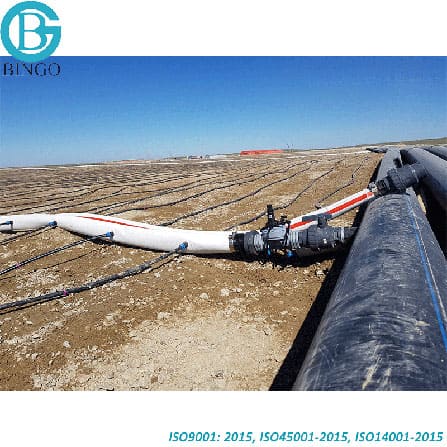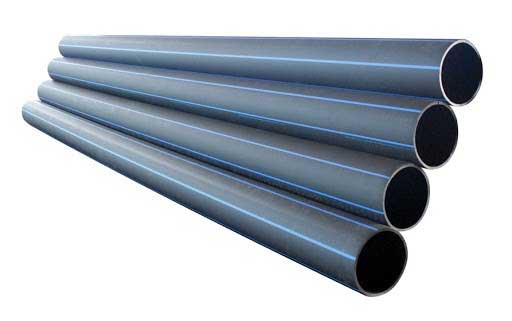Texas hdpe pipe manufacturer: Green Manufacturing
Wiki Article
Check Out the Manufacturing Refine Behind High-Quality HDPE Pipe and Its Applications
The manufacturing procedure of top notch HDPE pipelines is elaborate and methodical. It starts with the selection of basic materials that improve performance. Following this, ethylene undergoes polymerization to create material, which is then formed via extrusion. Quality control is extremely important, making sure that the end product fulfills rigorous criteria. The journey of HDPE pipes does not finish with manufacturing. Their applications across various industries expose a more comprehensive significance worth examining.Understanding HDPE: Properties and Advantages

High-density polyethylene (HDPE) is a flexible thermoplastic known for its longevity and resistance to numerous ecological aspects. This material displays exceptional tensile stamina, making it ideal for requiring applications. Its low-density structure contributes to a light-weight product, helping with convenience of dealing with and installation. HDPE likewise showcases amazing resistance to chemicals, which reduces degradation when exposed to extreme compounds.
The product's low wetness absorption better enhances its longevity, making it ideal for use in pipelines and tank. Additionally, HDPE is immune to ultraviolet (UV) radiation, making sure that products preserve their integrity also when exposed to sunlight. Its flexibility enables for the production of complex forms without jeopardizing stamina. The eco-friendly nature of HDPE, often acquired from recycled materials, includes in its allure, promoting sustainable practices in manufacturing. On the whole, these properties and advantages make HDPE a preferred selection for different commercial and consumer applications.
Raw Material Choice for HDPE Manufacturing
The option of raw materials for HDPE production is vital to validate the final item satisfies the wanted requirements and high quality standards. High-density polyethylene (HDPE) is mostly created from polymerized ethylene, originated from nonrenewable fuel sources such as natural gas or petroleum. The high quality of these feedstocks significantly affects the mechanical and thermal homes of the final HDPE.Additives additionally play a considerable function in enhancing HDPE's efficiency, including antioxidants, UV stabilizers, and colorants, which improve sturdiness and resistance to ecological aspects. The selection process must consider not only the chemical composition of the raw products however likewise their handling features to assure effective manufacturing.
The sourcing of raw materials need to focus on sustainability and compliance with ecological regulations, as responsible methods are vital in today's market. Ultimately, cautious basic material option lays the foundation for generating top quality HDPE pipes suitable for varied applications.
The Extrusion Refine: Shaping HDPE Pipe
The extrusion procedure plays an essential role in forming HDPE pipelines, beginning with thorough product prep work methods that assure excellent flow and consistency. Similarly vital is the style of the die, which directly influences the final measurements and surface area quality of the pipeline. Together, these aspects add significantly to the performance and top quality of HDPE pipe production.Product Preparation Strategies
Reliable manufacturing of HDPE pipelines begins with thorough product preparation strategies, particularly the extrusion procedure. Throughout this phase, high-density polyethylene material is very first dried to remove dampness, guaranteeing excellent circulation qualities. The material is after that fed into the extruder, where it undergoes home heating and melting, changing into a viscous state. This heating process is thoroughly controlled to maintain the product's honesty and efficiency. The molten HDPE is required with a die, shaping it into a constant pipeline form. Correct temperature management throughout extrusion is crucial, as it straight impacts the material's residential properties and the end product quality. When formed, the HDPE pipe is cooled down and cut to specified sizes, all set for subsequent handling and applications.Die Style Importance
Accuracy in die style plays a crucial function in the extrusion process of HDPE pipelines. The die acts as the final shaping tool, straight influencing the pipe's measurements, wall surface density, and surface finish. A properly designed die guarantees consistent material circulation, decreasing defects such as irregularities and weak places. The geometry of the die should be maximized to suit the details buildings of HDPE, including its viscosity and thermal actions during extrusion. Additionally, the cooling price of the material as it passes via the die can markedly influence the pipe's architectural integrity. Subsequently, spending in sophisticated die modern technology is essential for producers aiming to create high-grade HDPE pipes that satisfy industry criteria and customer expectations.Top Quality Control Steps in HDPE Manufacturing
Although numerous factors influence the high quality of HDPE pipe production, reliable quality control procedures are essential to assure uniformity and reliability in the final product. Trick top quality control techniques consist of strenuous material assessment, validating that the raw polyethylene fulfills well-known requirements for purity and density. Throughout the extrusion procedure, criteria such as temperature, pressure, and cooling time are carefully checked to preserve dimensional accuracy and structural honestyIn enhancement, post-production screening is vital; suppliers typically conduct hydrostatic examinations to assess the pipeline's strength and resistance to stress. Visual examinations for surface flaws further improve quality control. Qualification from pertinent requirements organizations, like ASTM or ISO, gives an added layer of reputation. By executing these thorough quality assurance steps, manufacturers can reduce problems, boost performance, and make sure that the HDPE pipelines satisfy the particular demands of different applications, ultimately bring about customer contentment and count on the product.
Applications of HDPE Pipeline Across Industries
HDPE pipes are used across various markets as a result of their toughness and flexibility. In water distribution systems, they assure efficient delivery, while in wastewater administration, they supply reputable remedies for waste transportation. Additionally, agricultural irrigation networks profit from HDPE's resistance to deterioration and flexibility, making it an optimal choice for modern-day farming techniques.
Water Distribution Equipments
A significant number of sectors depend on high-density polyethylene (HDPE) pipelines for efficient water distribution systems. Known for their resilience and resistance to rust, HDPE pipelines are widely utilized in municipal water networks, agricultural irrigation, and industrial applications. Their lightweight nature assists in simple handling and installment, lowering labor costs and time. Furthermore, HDPE pipes can accommodate numerous pressure levels, making them ideal for both low and high-pressure systems. Pipe Manufacturing Midland TX. The adaptability of the material enables smooth assimilation into existing facilities, decreasing the demand for considerable excavation. HDPE's resistance to chemical seeping assurances that the water supplied remains risk-free and tidy, making it a suitable option for keeping the top quality of potable water throughout numerous markets.Wastewater Monitoring Solutions
Effective water circulation systems additionally lead the method for innovative wastewater monitoring remedies, where high-density polyethylene (HDPE) pipes play a considerable duty. Renowned for their sturdiness and resistance to rust, HDPE pipelines are perfect for carrying wastewater in numerous setups. Their adaptability permits very easy setup in intricate settings, minimizing the need for comprehensive excavation. In addition, HDPE's smooth indoor surface minimizes rubbing, boosting circulation prices and performance. These pipes are also resistant to chemical leaching, guaranteeing that contaminants do not compromise the surrounding setting. Industries, towns, and treatment facilities significantly rely upon HDPE pipes for their integrity and durability, making them a favored choice for modern wastewater administration systems. This flexibility emphasizes the critical importance of HDPE pipelines across many applications.Agricultural Irrigation Networks
Agricultural irrigation networks profit substantially from the use of high-density polyethylene (HDPE) pipes, which offer efficient and reputable water delivery to crops. HDPE pipelines are lightweight, making them simple to transfer and mount, while their adaptability permits for different configurations in varied terrains. These pipelines demonstrate superb resistance to rust, chemicals, and UV radiation, guaranteeing resilience in severe farming atmospheres. Additionally, their smooth interior surface decreases friction loss, maximizing water flow and minimizing power expenses related to pumping. The longevity of HDPE pipelines, usually exceeding 50 years, adds to reduce upkeep and substitute costs. Farmers progressively depend on HDPE pipes to boost watering efficiency and promote sustainable agricultural techniques, inevitably leading to improved crop yields and source preservation.
Future Patterns in HDPE Pipeline Innovation
As the need for sustainable and efficient framework grows, improvements in HDPE pipeline technology are poised to transform various sectors. Emerging trends include the integration of clever modern technologies, such as sensors and IoT abilities, which assist in real-time tracking of pipeline problems, minimizing maintenance costs and avoiding leakages. Furthermore, the growth of innovative manufacturing strategies, such as 3D printing, is enabling the production of facility, tailored pipe designs that satisfy certain task needs.In addition, the concentrate on recycling and circular economic climate techniques is driving the development of HDPE pipelines made from recycled materials, enhancing sustainability. Improved jointing techniques, such as electro-fusion and mechanical installations, are additionally improving installment effectiveness and integrity. The expanding emphasis on environmental laws is pressing makers to take on greener production procedures, ensuring that HDPE pipelines not only fulfill sector criteria yet likewise promote an even more lasting future for framework development.
Frequently Asked Inquiries
How Does HDPE Compare to Other Plastic Materials?
HDPE exceeds many various other plastic materials relating to sturdiness, chemical resistance, and versatility. Its reduced density and high tensile stamina make it suitable for numerous applications, typically exceeding alternatives in both performance and longevity.What Are the Ecological Influences of HDPE Manufacturing?
The ecological effects of HDPE manufacturing include greenhouse gas exhausts, power consumption, and prospective pollution from making procedures. In addition, check here inappropriate disposal can result in dirt and water contamination, increasing issues about long-lasting environmental results.Can HDPE Pipeline Be Reused?
Yes, HDPE pipes can be reused. Numerous centers approve used HDPE for handling, transforming it into brand-new products. This reusing adds to sustainability initiatives, minimizing plastic waste while conserving resources and power in the manufacturing cycle.What Is the Life Expectancy of HDPE Piping?

How Do Temperature Variations Influence HDPE Pipe Performance?
Temperature variations substantially impact HDPE pipeline efficiency, affecting adaptability and toughness. High temperatures can bring about softening, while reduced temperatures may create brittleness, eventually influencing the pipeline's durability and viability for various applications in diverse environments.Report this wiki page